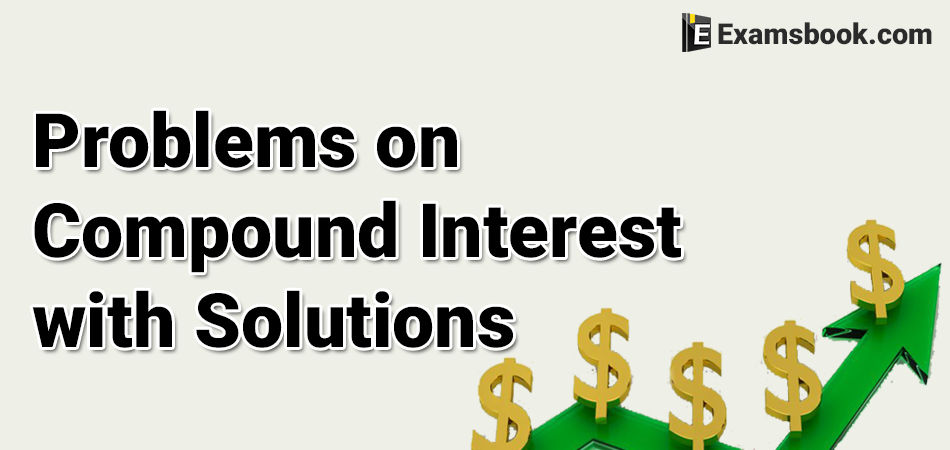Problems on Compound Interest with Solutions for Bank Exams

Compound interest is a common topic in bank exams and all other competitive exams. Here given compound interest problems are important from the perspective of SSC and Banking exams. So, Here are problems on compound interest with solutions with the different ways which takes more time to solve.
So by understanding these ways to solve compound interest problems, you can save your time in the competitive exam and improve your score as well as your performance. You should know Compound interest formula with examples by visit here.
Compound Interest Problems with Solutions for Competitive Exams
Q.1. The difference between simple and compound interests compounded annually on a certain sum of money for 2 years at 4% per annum is Re. 1. The sum (in Rs.) is:
(A) 625
(B) 630
(C) 640
(D) 650
Ans . A
Let the sum be Rs. x. Then,
C.I. = [x{1+(4/100)}2-x]
= [(676/625)x - x]
=(51/625)x
S.I = [(x*4*2)/100]
=2x/25
⸫ (51x/625)-(2x/25)=1
→ x=625.
Q.2. A man invests Rs.5000 for 3 years at 5% p.a. compound interest reckoned yearly. Income tax at the rate of 20% on the interest earned is deducted at the end of each year. Find the amount at the end of the third year
(A) Rs.5624.32
(B) Rs.5423
(C) Rs.5634
(D) Rs.5976
Ans . A
5% is the rate of interest. 20% of the interest amount is paid as tax.i.e 80% of the interest amount stays back.
if we compute the rate of interest as 80% of 5% = 4% p.a., we will get the same value.
The interest accrued for 3 years in compound interest = 3 x simple interest on principal + 3 x interest on simple interest + 1 x interest on interest on interest.
= 3 x (200) + 3 x (8) + 1 x 0.32 =600 + 24 + 0.32 = 624.32
The amount at the end of 3 years = 5000 + 624.32 = 5624.32
Q.3. A bank offers 5% compound interest calculated on half-yearly basis. A customer deposits Rs. 1600 each on 1st January and 1st July of a year. At the end of the year, the amount he would have gained by way of interest is:
(A) Rs. 120
(B) Rs. 121
(C) Rs. 122
(D) Rs. 123
Ans . B
Amount = Rs. [1600x{1 + 5/(2x100)}2 + 1600x{(1 + 5/(2x100)}]
= Rs.[1600x(41/40)x(41/40)+1600x(41/40)]
= Rs.[1600x(41/40){(41/40)+1}]
= Rs.[(1600x41x81)/(40x40)]
= Rs.3321. Compound Interest = Rs.3321 - Rs.3200 = Rs.121
Q.4. The population of a town was 3600 three years back. It is 4800 right now. What will be the population three years down the line, if the rate of growth of population has been constant over the years and has been compounding annually?
(A) Rs.600
(B) Rs,6400
(C) Rs.6500
(D) Rs.6600
Ans . B
The population grew from 3600 to 4800 in 3 years. That is a growth of 1200 on 3600 during three-year span. Therefore, the rate of growth for three years has been constant. The rate of growth during the next three years will also be the same.
Therefore, the population will grow from 4800 by (4800)×(1/3)= 1600
Hence, the population three years from now will be 4800 + 1600 = 6400
Q.5. The compound interest on Rs. 30,000 at 7% per annum is Rs. 4347. The period (in years) is:
(A) 2
(B) 1
(C) 3
(D) 4
Ans . A
Amount = Rs. (30000 + 4347) = Rs. 34347.
Let the time be n years.
Then, 30000 [{1 +(7/100)}n= 34347
→ (107/100)n = (34347/30000)
= (11449/10000)=(107/100)2
n = 2 years.
Q.6. Find the compound interest on Rs. 16,000 at 20% per annum for 9 months, compounded quarterly
(A) 2422
(B) 2522
(C) 2622
(D) 2722
Ans . B
Principal = Rs. 16000; Time = 9 months =3 quarters;
Rate = 20% per annum = 5% per quarter.
Amount = Rs. [16000 x (1+(5/100))3] = Rs. 18522.
CJ. = Rs. (18522 - 16000) = Rs. 2522
Q.7. The compound interest on a certain sum for 2 years at 10% per annum is Rs. 525. The simple interest on the same sum for double the time at half the rate percent per annum is
(A) Rs.4000
(B) Rs.500
(C) Rs.600
(D) Rs.800
Ans . B
Let the sum be Rs. P.
Then, [p(1+10/100)2-p]=525
Sum =Rs.2500
S.I.= Rs.(2500*5*4)/100
= Rs. 500
Q.8. The compound interest on a sum of money for 2 years is rs.832 and the simple interest on the same sum for the same period is rs.800 .the difference between the compound interest and simple interest for 3 years
(A) Rs.48
(B) Rs.66.56
(C) Rs.98.56
(D) None of these
Ans . C
difference in C.I and S.I in 2years =Rs.32
S.I for 1year =Rs.400
S.I for Rs.400 for one year =Rs.32
rate=[(100×32)/(400×1)%=8%
Difference between in C.I and S.I for 3rd year
=S.I on Rs.832= Rs.(832×8×1)/100=Rs.66.56.
Q.9. The difference between simple interest and compound interest on Rs. 1200 for one year at 10% per annum reckoned half yearly is
A) Rs.2.50
B) Rs.3
C) Rs.4
D) Rs.4.50
Ans . B
S.I = Rs.(1200x10x1/100) = Rs.120.
C.I = Rs[(1200x1+5/100)² -1200]
= Rs.123.
Difference = Rs.[123-120] = Rs. 3.
Q.10. Reena took a loan of Rs. 1200 with simple interest for as many years as the rate of interest. If she paid Rs. 432 as interest at the end of the loan period, what was the rate of interest?
(A) 3.6
(B) 6
(C) 18
(D) Cannot be determined
Ans . B
Let rate = R% and time = R years.
Then, [(1200×R×R)/100)]=432
→ 12R2=432
→ R2=36
→R=6
If you are facing any problems in the compound interest problems with solutions, ask me in the comment section without any hesitation. Visit on the next page for more practice.



